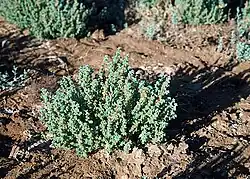Maireana luehmannii
| Maireana luehmannii | |
|---|---|

| |
| Scientific classification | |
| Kingdom: | Plantae |
| Clade: | Tracheophytes |
| Clade: | Angiosperms |
| Clade: | Eudicots |
| Order: | Caryophyllales |
| Family: | Amaranthaceae |
| Genus: | Maireana |
| Species: | M. luehmannii
|
| Binomial name | |
| Maireana luehmannii | |
| Synonyms[1] | |
| |
Maireana luehmannii, commonly known as Luehman's bluebush,[2] is a species of flowering plant in the family Chenopodiaceae and is endemic to Australia. It is an erect, widely branched perennial herb, shrub or subshrub with woolly branches when young, fleshy, egg-shaped leaves, and pairs of bisexual flowers, the fruiting perianth flattened with five wings divided into two or more spiny lobes.
Description
Maireana luehmannii is an erect, widely branched perennial herb, shrub or subshrub that typically grows to a height of up to 40 cm (16 in) and has branches covered with woolly hairs when young. Its leaves are arranged alternately, fleshy, egg-shaped with the narrower ends towards the base, 2–13 mm (0.079–0.512 in) long and 1.5–3.5 mm (0.059–0.138 in) wide, and covered with short, silky hairs. The flowers are bisexual, arranged in pairs in leaf axils. The fruiting perianth is almost woody, 5–12 mm (0.20–0.47 in) wide, the upper perianth flat with five wings 2–3 mm (0.079–0.118 in) long, often irregularly curved and divided into two or more spiny lobes.[3][4][5]
Taxonomy
This species was first described in 1890 by Ferdinand von Mueller who gave it the name Bassia luehmannii in The Victorian Naturalist from specimens collected near the Finke River by "Rev. W.F.Schwarz".[6][7] In 1975, Paul G. Wilson transferred the species to Maireana as M. luehmannii in the journal Nuytsia.[3][8] The specific epithet (luehmannii) honours Johann George Luehmann.[9]
Distribution and habitat
Luehman's bluebush grows near salt lakes from east-central Western Australia[10] to the south of the Northern Territory,[5] northern South Australia[2] and Western Queensland.[10]
Conservation status
Maireana luehmannii is listed as "not threatened" by the Government of Western Australia Department of Biodiversity, Conservation and Attractions,[10] of "least concern" under the northern Territory Government Territory Parks and Wildlife Conservation Act and the Queensland Government Nature Conservation Act 1992.[11]
References
- ^ a b "Maireana luehmannii". Australian Plant Census. Retrieved 25 July 2025.
- ^ a b "Maireana luehmannii". Seeds of South Australia. Retrieved 25 July 2025.
- ^ a b Wilson, Paul G. (1975). "A Taxonomic Revision of the genus Maireana (Chenopodiaceae)". Nuytsia. 2 (1): 20–21. Retrieved 26 July 2025.
- ^ Wilson, Paul G. "Maireana luehmannii". Flora of Australia. Australian Biological Resources Study, Department of Climate Change, Energy, the Environment and Water: Canberra. Retrieved 26 July 2025.
- ^ a b "Maireana luehmannii". Northern Territory Government. Retrieved 26 July 2025.
- ^ "Bassia luehmannii". Australian Plant Name Index. Retrieved 26 July 2025.
- ^ von Mueller, Ferdinand (1890). "Descriptions of new Australian plants, with occasional other annotations (continued)". The Victorian Naturalist. 7 (4): 47–48. Retrieved 26 July 2025.
- ^ "Maireana luehmannii". Australian Plant Name Index. Retrieved 26 July 2025.
- ^ George, Alex; Sharr, Francis (2021). Western Australian Plant Names and Their Meanings (3rd ed.). Kardinya, WA: Four Gables Press. p. 250. ISBN 9780958034180.
- ^ a b c "Maireana luehmannii". FloraBase. Western Australian Government Department of Biodiversity, Conservation and Attractions.
- ^ "Taxon - Maireana luehmannii". Queensland Government WildNet. Retrieved 26 July 2025.